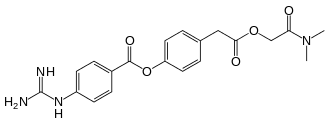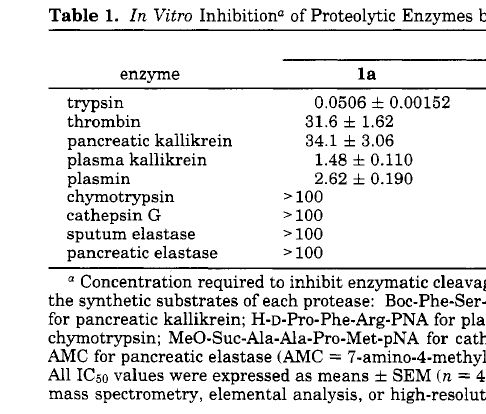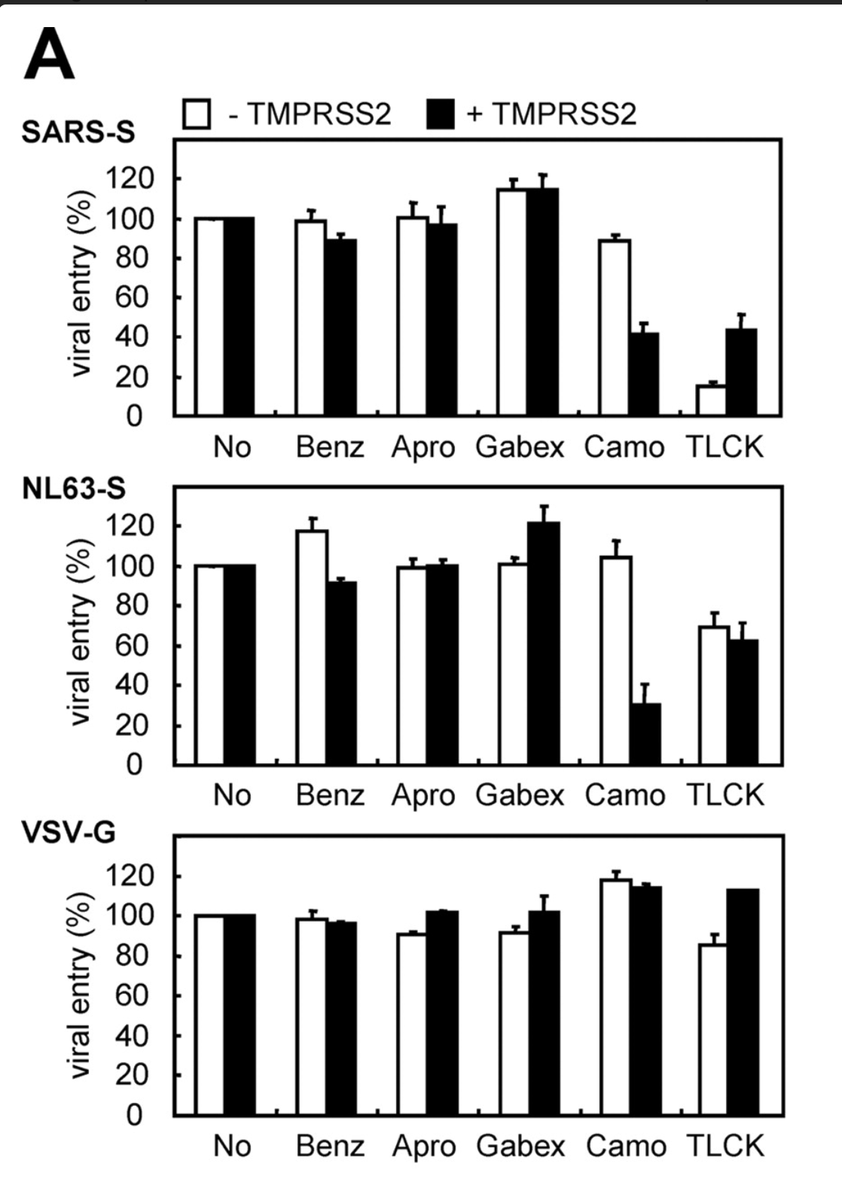OK so let& #39;s talk about camostat, because I& #39;m starting to worry about it as a #COVID19 repurposing candidate. It emerged based on this Cell paper, but a LOT of assumptions are buried in the science.
https://www.cell.com/cell/fulltext/S0092-8674(20)30229-4">https://www.cell.com/cell/full...
https://www.cell.com/cell/fulltext/S0092-8674(20)30229-4">https://www.cell.com/cell/full...
That Cell paper calls camostat "calls camostat “a clinically proven inhibitor of the cellular serine protease TMPRSS2” – which is not strictly correct.
It’s a clinically used drug (in Japan)
It has been shown to act on TMPRSS2 indirectly
Separate points. @Dereklowe
It’s a clinically used drug (in Japan)
It has been shown to act on TMPRSS2 indirectly
Separate points. @Dereklowe
So what is camostat used for?
It& #39;s a serine protease inhibitor, and in Japan it& #39;s approved for treating pancreatitis. In that indiciation, doses are 600 mg are given. Data indicates it acts via anti-inflammatory action: https://www.nature.com/articles/3700203">https://www.nature.com/articles/...
It& #39;s a serine protease inhibitor, and in Japan it& #39;s approved for treating pancreatitis. In that indiciation, doses are 600 mg are given. Data indicates it acts via anti-inflammatory action: https://www.nature.com/articles/3700203">https://www.nature.com/articles/...
First – camostat (FOY 305) was not developed as TMPRSS2 inhibitor.
References to later analogs than FOY are shown in https://pubs.acs.org/doi/10.1021/jm00014a003">https://pubs.acs.org/doi/10.10...
A panel of serine proteases are tested. 1a in the manuscript is camostat, and the main enzyme inhibited was trypsin (50 nM IC50).
References to later analogs than FOY are shown in https://pubs.acs.org/doi/10.1021/jm00014a003">https://pubs.acs.org/doi/10.10...
A panel of serine proteases are tested. 1a in the manuscript is camostat, and the main enzyme inhibited was trypsin (50 nM IC50).
So when did camostat emerge as a TMPRSS2 inhibitor?
First reference is a paper looking at SARS entry inhibitors, in a study published in 2012: https://jvi.asm.org/content/86/12/6537.long">https://jvi.asm.org/content/8...
First reference is a paper looking at SARS entry inhibitors, in a study published in 2012: https://jvi.asm.org/content/86/12/6537.long">https://jvi.asm.org/content/8...
In that paper, camstat was found to inhibit cell entry. It shows:
1. that TMPRSS2 is important for viral entry using genetic approaches
2. that camostat only prevented viral entry when TMPRSS2 was expressed in cells
1. that TMPRSS2 is important for viral entry using genetic approaches
2. that camostat only prevented viral entry when TMPRSS2 was expressed in cells
AT NO POINT HAS ANYONE SHOWN CAMOSTAT TO BE A BIOCHEMICAL INHIBITOR OF TMPRSS2 - THAT I CAN FIND.
To be clear: I do not take issue with the data at all.
Only the conclusions.
To be clear: I do not take issue with the data at all.
Only the conclusions.
From a PK point of view it& #39;s even more complicated:
Camostat isn& #39;t stable:
Parent drug was not detected in human plasma either during or after infusion of 14C-camostat mesylate owing to rapid hydrolysis of the side-chain ester group (t1/2 < 1 min). https://www.tandfonline.com/doi/abs/10.3109/00498259409043223">https://www.tandfonline.com/doi/abs/1...
Camostat isn& #39;t stable:
Parent drug was not detected in human plasma either during or after infusion of 14C-camostat mesylate owing to rapid hydrolysis of the side-chain ester group (t1/2 < 1 min). https://www.tandfonline.com/doi/abs/10.3109/00498259409043223">https://www.tandfonline.com/doi/abs/1...
There& #39;s a follow-up study of camostat on MERS, a rewind-repeat compared to the SARS paper, and now camostat is "a TMPRSS2 inibitor":
https://www.ncbi.nlm.nih.gov/pubmed/24027332 ">https://www.ncbi.nlm.nih.gov/pubmed/24...
https://www.ncbi.nlm.nih.gov/pubmed/24027332 ">https://www.ncbi.nlm.nih.gov/pubmed/24...
Now getting back to the Cell paper, they are using 100 uM (micromolar) camostat. 100 MICROMOLAR in vitro, a 1 min half-life, and no direct demonstration of target inhibition for a non-specific protease inhibitor.
I can’t find any literature on the primary metabolite FOY-251 as a TMPRSS2 inhibitor - or even testing in vitro on viral entry - but it is described elsewhere as an & #39;active metabolite& #39; in general studies:
https://www.ncbi.nlm.nih.gov/pubmed/19145783 ">https://www.ncbi.nlm.nih.gov/pubmed/19...
https://www.ncbi.nlm.nih.gov/pubmed/19145783 ">https://www.ncbi.nlm.nih.gov/pubmed/19...
So what does all this mean? I want camostat to work in clinical trials for #COVID19, but I worry that no-one has even scratched back through the literature to do due diligence on what #camostat does, and what it was developed for.
This @ScienceMagazine news piece marvels at the speed to trial, but we need to ensure that we ask critical questions about our drug repurposing candidates along the way.
Fin. https://www.sciencemag.org/news/2020/04/these-drugs-don-t-target-coronavirus-they-target-us">https://www.sciencemag.org/news/2020...
Fin. https://www.sciencemag.org/news/2020/04/these-drugs-don-t-target-coronavirus-they-target-us">https://www.sciencemag.org/news/2020...
Hmm i think @JSheltzer might like this thread actually.

 Read on Twitter
Read on Twitter




